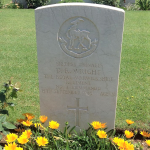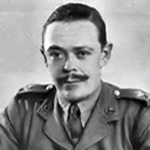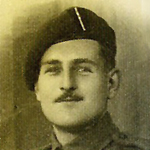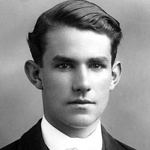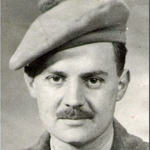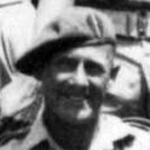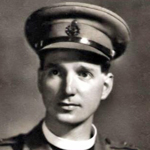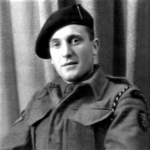2 Commando, Some of the Men
Primary tabs
There is a worn-out cliché which goes as: "They came from all walks of life". It is descriptive and fits, so we will use it one more time because it certainly describes the pre-service backgrounds of the people who took their places in the ranks of No. 2 Commando. They were an interesting assortment and what follows is some insight as to how their lives unfolded and sometimes terminated.
nb. click/touch the names for additional info
Lance Sergeant Joseph Jackson
Joe was a former Isle of Man taxi-driver who was an old hand from the Independent Company days and was there from the beginning of the Commando. Awarded the Distinguished Conduct Medal Joe almost made it to the end of the war, K.I.A. 27 February, 1945, Age 39, at Lake Comacchio, Italy.
Private Dennis Wright
Dennis was a student from Birmingham, although judging by his age probably schoolboy would have been more accurate. This lad fought in the battle of Dragone Hill in the Salerno landing and was K.I.A. 13 September, 1943. Dennis was 18.
Lance Sergeant Frederick Peachey 
Lance Corporal John Phelan
Johnny was educated at an expensive finishing school in Belgium. He came from a family that operated a flourishing restaurant business in London. Johnny was in the campaigns in Sicily, Italy, Yugoslavia and Albania. He was commissioned from the ranks as a Lieutenant in 1945. The thing that the author remembers most about Johnny is that he got on our nerves relating about yummy hot roast beef sandwiches at his family restaurant while we were in the process of consuming our usual meal of corned-beef and hard-tack biscuits.
Captain The Duke Of Wellington
Sergeant Jack Moores
Lance Corporal William Cant
Lieutenant Thomas Peyton
Captain Joseph Houghton MC
Lance Sergeant Charles Blattner
Reverend Captain Gareth Banting
The men of No. 2 Commando were indeed a quiet group of men who worked very well together. They said very little concerning their pre-war backgrounds. The Sergeant who was in civil life a floor-walker in a department store was always on very good terms with the bookie (sorry, I mean turf-accountant) and the scion of a wealthy family with huge land holdings and business companies was quite at home commanding his group of men which included men from such diverse backgrounds as a gardener and part-time grave digger, a Lloyds Bank management trainee, a former office-boy, a rather elderly building contractor, professional soldiers, a solicitor, labourers, an elementary school-teacher, a couple of lorry drivers and a former communist party worker. The list of pre-war vocations could go on ad infinitum.
Some time statistics will tell a story or be informative, the author has thought of a few:
The average age of the soldiers of No. 2 Commando was 23. The youngest member of the unit to fall in battle was aged 18 and, at the other end of the scale, the eldest man to be K.I.A. was aged 45.
The volunteer soldiers of the Commando came from 54 different Regiments of the Line and from all the Corps of the army with the exception of the Corps of Military Police. Somehow, strangely enough, the lack of C.M.P. representation was not a cause of great concern or sorrow to the troops.
The South Lancashire Regiment (The Prince of Wales Own) supplied the largest contingent of the volunteers, with the Royal Artillery coming in second place.
The origins of the 2 Commando boys lay in many far-flung lands. As the author’s memory goes they were from England, Wales, Scotland, Canada, Southern Rhodesia, Palestine, Switzerland and the Republic of Ireland plus a couple of lads who were refugees and thus, stateless.
Only one soldier of the Commando had seen service in World War I. That was Major Bill Copeland who was awarded a D.S.O. for his role at St. Nazaire.
Only one officer had been with the B.E.F. at Dunkirk. That was Mad Jack Churchill himself. The author muses that if the B.E.F. had all consisted of men of the calibre of Mad Jack, history would now be describing Dunkirk as an attack instead of an evacuation.
About 30 percent of No. 2 were graduates of Achnacarry. This percentage dwindled as No. 2 was forced to replace its losses in 1943, 1944 and 1945 with volunteers recruited from Gibraltar and also the 5th and 8th Army in Italy. Alumni of Col. Charlie Vaughan’s finishing school were inclined to be a trifle ‘snobby’ about their training background. As the news of the ardours of Achnacarry became public domain, the Achnacarry boys were possibly even more insufferable.
What always united the men was their supreme, sincere regard for the family of No. 2 and their collective desire to stay put in its ranks. According to what information this author can assemble, about 72 men (all ranks) were ‘Returned to Unit’ for one reason or another. Although any man was free to do so, only a handful of the men decided to leave the Commando of their own volition. They were never allowed to return.
These have been an odd collection of thoughts of this, now 83 years gone, author who can only now say that it was good to be one of THE MEN.
nb. The above account is part of the overall history of No 2 Commando by Bob Bishop No 2 Cdo.
Ask Questions / Add Information / Add Photos
Read some frequently asked questions here [FAQ's].

